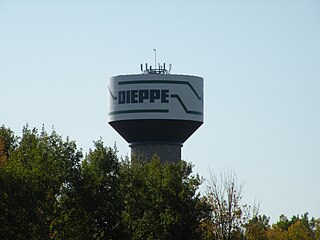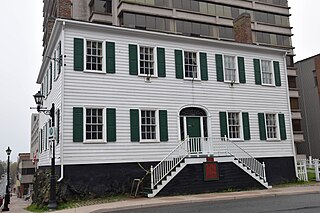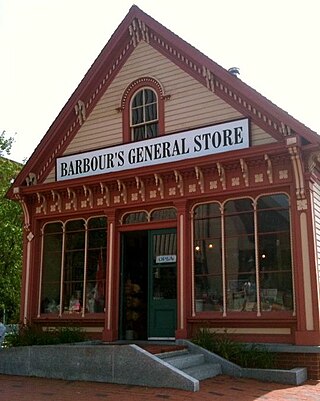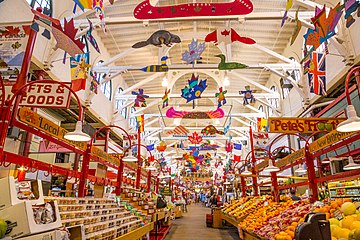History
Prior to the establishment of the market at its current location, the city of Saint John operated several public markets. [3] The government of New Brunswick enacted a law permitting a public fish market, located in the Water Street slips to be operated by the city of Saint John, in 1855. [4] Another was a hay market, run at the head of King Street. [3] [5] The first two buildings to house the market, both made of wood, were destroyed by fire. [2] The current building was designed by architects J.T.C. McKean and G.E. Fairweather in the Second Empire style, and completed in 1876. [6] [7] The building narrowly escaped the 1877 fire which destroyed 40% of the city's buildings. [8]
The City Market has a unique interior roof structure, which resembles an inverted ship's keel. [9] Made of wooden trusses, the structure was reportedly built by unemployed ship carpenters of the day. [10] Also, the floor slopes with the natural grade of the land. [11]
Some of the businesses in the market have been operating continuously there for more than 100 years. Facing onto Kings Square, the market is connected to the city's indoor pedway system.
The market was designated a National Historic Site of Canada in 1986. [12]

Fredericton is the capital city of the Canadian province of New Brunswick. The city is situated in the west-central portion of the province along the Saint John River, also known by its Indigenous name of Wolastoq, which flows west to east as it bisects the city. The river is the dominant natural feature of the area. One of the main urban centres in New Brunswick, the city had a population of 63,116 and a metropolitan population of 108,610 in the 2021 Canadian census. It is the third-largest city in the province after Moncton and Saint John.

Saint John is a seaport city located on the Bay of Fundy in the province of New Brunswick, Canada. It is Canada's oldest incorporated city, established by royal charter on May 18, 1785, during the reign of George III. The port is Canada's third-largest by tonnage with a cargo base that includes dry and liquid bulk, break bulk, containers, and cruise. The city was the most populous in New Brunswick until the 2016 census, when it was overtaken by Moncton. It is currently the second-largest city in the province, with a population of 69,895 over an area of 315.59 km2 (121.85 sq mi).

Dieppe is a city in the Canadian maritime province of New Brunswick. Statistics Canada counted the population at 28,114 in 2021, making it the fourth-largest city in the province. On 1 January 2023, Dieppe annexed parts of two neighbouring local service districts; revised census figures have not been released.

Bathurst is a city in northern New Brunswick with a population of 12,157 and the 4th largest metropolitan area in New Brunswick as defined by Census Canada with a population of 31,387 as of 2021. The City of Bathurst overlooks Nepisiguit Bay, part of Chaleur Bay and is at the estuary of the Nepisiguit River.

Canada has a large domestic and foreign tourism industry. The second largest country in the world, Canada's wide geographical variety is a significant tourist attractor. Much of the country's tourism is centred in the following regions: Toronto, Montreal, Quebec City, Vancouver/Whistler, Niagara Falls, Vancouver Island, Canadian Rockies, British Columbia's Okanagan Valley, Churchill, Manitoba and the National Capital Region of Ottawa-Gatineau. The large cities are known for their culture, diversity, as well as the many national parks and historic sites.

Saint Andrews is a town in Charlotte County, New Brunswick, Canada. The historic town is a national historic site of Canada, bearing many characteristics of a typical 18th century British colonial settlement, including the original grid layout with its market square, and the classical architecture.

The Bank of New Brunswick, established in 1820, was the first Canadian bank to operate under a charter. The bank operated independently in New Brunswick and later in Prince Edward Island until it merged with the Bank of Nova Scotia in 1913.

The Bytown Museum is a museum in Ottawa located in the Colonel By Valley at the Ottawa Locks of the Rideau Canal at the Ottawa River, just below Parliament Hill. Housed in the Commissariat Building, Ottawa's oldest remaining stone building, the museum provides a comprehensive overview of the origins of Bytown and its development and growth into the present city of Ottawa.

Windsor Station is a former railway station in Montreal, Quebec, Canada. It used to be the city's Canadian Pacific Railway (CPR) station, and served as the headquarters of CPR from 1889 to 1996. It is bordered by Avenue des Canadiens-de-Montréal to the north, Peel Street to the east, Saint Antoine Street to the south and the Bell Centre to the west.

Partridge Island is a Canadian island located in the Bay of Fundy off the coast of Saint John, New Brunswick, within the city's Inner Harbour.

McAdam station is a former railway station that dominates the village of McAdam, New Brunswick, Canada. The station is the largest passenger station in the province but since the December 17, 1994, abandonment of Via Rail's Atlantic passenger train, it no longer sees rail service and is partially used as a museum.

St. Anne's Chapel is a Gothic Revival Anglican chapel of ease in Fredericton, New Brunswick. Constructed between 1846 and 1847, it was designed by British-born architect Frank Wills. St. Anne's Chapel is a National Historic Site of Canada.

Loyalist House is a museum and National Historic Site located in uptown Saint John, New Brunswick, Canada. It was the home of the prosperous Merritt family, who occupied it from its completion in 1817 until 1958. It was taken over by the New Brunswick Historical Society in 1961. Its address is 120 Union Street.

Barbour's General Store was a museum and tourist hub in Saint John, New Brunswick. It was an authentic 19th-century general store building, preserved and used to recreate a Victorian-era educational experience for visitors. It was located at the intersection of King Street and Prince William Street just outside the Trinity Royal Historic Conservation Area in the city's uptown. On August 22, 2015 the shop was re-opened to the public as a functioning business and local information centre. On June 13, 2023 the building was proposed to demolish after a fire in January 2022. It was dismantled in July 2023.

The Trinity Royal Heritage Conservation Area is a historic district in Saint John, New Brunswick's uptown. The City of Saint John designated the area as the city's first heritage conservation area in 1982; it has since expanded in area. Surrounding the Trinity Anglican Church, the area includes several National Historic Sites of Canada within its boundaries. Much of the area consists of Victorian brick buildings raised after The Great Fire of Saint John, New Brunswick that destroyed much of the city's central peninsula in 1877.

René-Arthur Fréchet was a Canadian architect who was active in New Brunswick and Nova Scotia, modern day Acadia. He designed many churches and public buildings, a number of which are now protected for their architectural significance.
RCAF Station Saint John or RCAF Aerodrome Saint John, was a military aerodrome that was established at the Saint John Municipal Airport in 1939. The airport was located in the neighborhood of Millidgeville in the city of Saint John, New Brunswick.

Vallée-des-Rivières is a town in the Canadian province of New Brunswick. It was formed through the 2023 New Brunswick local governance reforms.





















